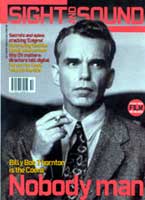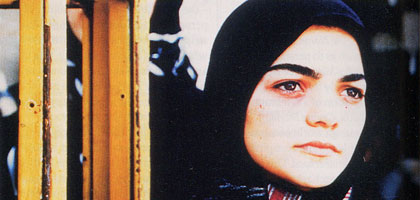
The Circle
Iran/Italy/Switzerland 2001

Reviewed by Julian Graffy
Synopsis
Our synopses give away the plot in full, including surprise twists.
A street in Tehran, the present. Three women, headscarfed and identically swathed in dark blue, anxiously make a phone call. They have exit passes from prison, but one, Maedeh (Maedeh Tahmasbi), is swiftly rearrested. Arezou (Maryam Parvin Almani) and Nargess (Nargess Mamizadeh) plan to go to Raziliq, Nargess' home village, but need money for the fare. Arezou gets the money but eventually decides not to go. Nargess, too, gets off the bus and wanders in search first of Arezou and then of their friend Pari (Fereshteh Sadr OrafaÏ), also released that morning. Pari is thrown out of her father's house and goes to find another former prisoner, Elham (Elham Saboktakin), a nurse who Pari hopes will help her get an abortion. But Elham has kept her past secret from her doctor husband and will not help.
Back wandering the streets of the city Pari meets Nayereh (Fatemeh Naghavi), who abandons her young daughter in the hope that she will get a better life. Later Nayereh accepts a lift from a man, but they run into a police check and she risks arrest. The police concentrate on a defiant young woman, Mojgan (Mojgane Faramarz), and Nayereh slips away. Mojgan is arrested and taken to a cell. Among the women already there are the trio from the start of the film.
Review
In the prologue to The Circle, unseen behind a black screen and the opening credits, we hear the cries of a woman, Solmaz, giving birth. The film's first words, 'It's a girl,' are met with despair by the woman's mother - 'but the ultrasound said it would be a boy.' She is certain that her daughter's parents-in-law will demand a divorce. This chilling vignette sets the scene for a connected series of powerful and engaging stories of women's experience in modern Tehran, their force enhanced by the film's stunning formal confidence and audacity.
Like Panahi's acclaimed first feature, The White Balloon (1995), The Circle uses the quests of its central characters to provide a subtle and original evocation of city life. But whereas the earlier film was unashamed to trade in the charming and the picturesque, and its plot hinged upon a large element of fakery, The Circle jettisons these props, displaying Tehran as a place of relentless intimidating bustle, seared by the noise of traffic and car horns. Above all it is a city of men - on Tehran's streets men trade, make music, ride motorbikes, swoop down in their police vans and arrest people. In this world, women are excluded, fearful, conscious of the arbitrariness with which danger can strike. Newly released from prison, Nargess alternately gazes with wonder at the energy and vigour of it all - the shops speaking the signs of modernity, the Western perfumes, a Swatch advert, a shirt 'made in Turkey, best quality' - or hides in dark corners to avoid being seen.
The men who run this world are rarely glimpsed. Elham's Pakistani husband is seen only though a window, while the cinema cashier Monire's is not seen at all. But they have arbitrary power over the lives of their wives - the Pakistani doctor has divorced his first wife, who just didn't suit, and Monire's husband took a second wife while Monire was in prison. Faced with this, the women have a choice between solidarity and frightened subservience. The first of these causes Monire to be grateful to wife number two for looking after her children in her absence. It is the latter that makes Elham unable to offer Pari the help she needs.
Jafar Panahi's contention is that women are powerless and marginalised, dependent on the whims, prejudices, and occasional kindnesses of men. This is realised through a series of dazzling visual and narrative devices. Always covered from head to toe, they additionally don dark chadors at moments of danger, which render them indistinguishable and almost literally invisible. Fearing re-arrest at the start, Arezou and Nargess run away looking like two huge crows. When Pari visits her prison friend Monire, their conversation is hidden as men buying tickets completely block the screen. This invisibility is compounded by a pervasive uncertainty about their fates - we are given no backstories, no reasons for their arrest, and the minimal information about their plans and desires is delayed or withheld with disorientating effect. In key cases we are not even given the characters' names until they are required to identify themselves to authority - Nargess in order to be sold a bus ticket, Nayereh when she faces arrest. In most cases, too, the characters share the actresses' own names, adding to the sense of universality. And the formal structure of a relay of incomplete narratives leaves the viewer with a shockingly unsettling series of unfinished stories, untold lives.
The Circle is also related through a subtly deployed system of metaphors. Throughout the film women look out at the world through bars, and windows and doors slam shut; they are forbidden to smoke in public places; they fail to complete their journeys to a place of safety. Seeing a cheap copy of a Van Gogh, Nargess recognises it as the paradisaical Raziliq of her childhood, 'only the painter didn't get it quite right.' And throughout the film, a wedding party wends its way as ironic commentary.
Panahi observes the classical unities - this is the story of a single day in a single town, a day in the life of everywoman and her daughter. At the end, when darkness falls and the women enter a communal cell, the metaphor of women's life as a prison is uninsistently realised. The Circle of the film's title is a place in Tehran where Pari goes to meet Monire, but it also serves as a subtle motif of closure. As the film ends, a young male prison guard asks whether Solmaz Gholami is among the women in the cell. But she is not there, having been transferred to the maternity hospital of the start of the film to give birth to a daughter. Sound outlasts vision. Against the black screen of the closing credits, a cell door slams.
Credits
- Director
- Jafar Panahi
- Producer
- Jafar Panahi
- Screenplay
- Kambozia Partovi
- Based on an idea by
- Jafar Panahi
- Director of Photography
- Bahram Badakhshani
- Editor
- Jafar Panahi
- Art Director
- Iraj Raminfar
